![]()
![]()
![]()
Use LEFT and RIGHT arrow keys to navigate between flashcards;
Use UP and DOWN arrow keys to flip the card;
H to show hint;
A reads text to speech;
64 Cards in this Set
- Front
- Back
- 3rd side (hint)
|
What are bone’s two primary minerals that are embedded in collagen and confer hardness and rigidity to bone. |
Calcium and phosphate |
|
|
|
Collagen |
Bone’s main protein, imparts flexibility to bone |
|
|
|
Osteocytes |
Mature bone cells |
|
|
|
Osteoblasts |
Bone forming cells |
|
|
|
Osteoclasts |
Bone resorbing cells |
|
|
|
Compact bone |
A layer of bone tissue that covers most of the bones |
|
|
|
Spongy bone |
Another type of bone tissue, contains many bone marrow-filled spaces. Found at the ends of long bones and is thebsite of blood cell formation |
|
|
|
Medullary cavity |
A hollow cavity that is found in long bones in the arms and legs. Filled with yellow bone marrow primarily consisting of fat |
|
|
|
Ossification |
A process in which new bone forms at the growth plate, pushing the ends of the bone apart from each other until full growth is achieved, during this process cartilage turns into bone |
|
|
|
Periosteum |
A highly vascular layer of fibrous connective tissue that covers the surface of bones. Contains cells that are capable of forming new bone tissue and serves as a site of attachment for tendons |
|
|
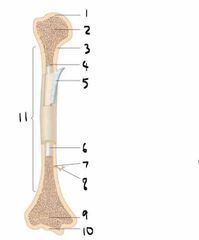
1. |
Proximal epiphysis |
|
|

2. |
Spongy bone |
|
|

3. |
Compact bone |
|
|

4. |
Medullary cavity |
|
|
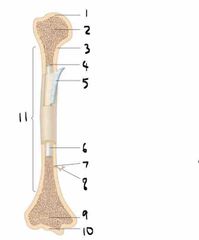
5. |
Periosteum |
|
|
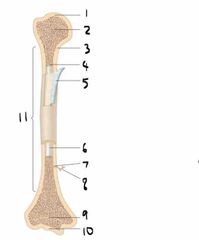
6. |
Endosteum |
|
|
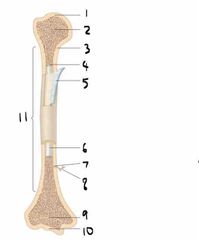
7. |
Nutrient foramen |
|
|

8. |
Nutrient vessel |
|
|
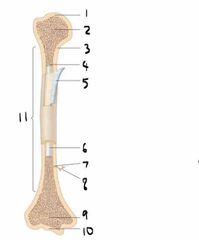
9. |
Epiphyseal plate (growth plate) |
|
|
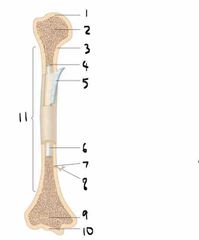
10. |
Distal epiphysis |
|
|

11. |
Diaphysis |
|
|
|
9. |
Epiphyseal plate (growth plate) |
|
|
|
Synoviale membrane |
Is lined with the inner surface of the joint capsule, secretes synoviale fluid |
|
|
|
Synovial fluid |
Lubricates the joints, secretes by synovial membrane |
|
|
|
Bursae |
Sacs of synovial fluid, situated near some joints to reduce friction during movement |
|
|
|
Where is skeletal or voluntary muscle found in |
Muscles that are firmly attached to bones by tendons |
|
|
|
Tendons |
Flexible but inelastic cord of strong fibrous collagen tissue attaching a muscle to a bone |
|
|
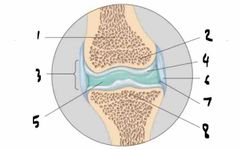
1. |
Spongy bone |
|
|

2. |
Articulating bone |
|
|
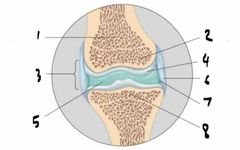
3. |
Joint capsule |
|
|
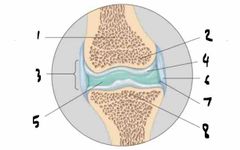
4. |
Cartilage |
|
|
|
Cartilage |
Connective tissue. A firm tissue but is softer and more flexible than bone |
|
|

5. |
Synovial fluid |
|
|

6. |
Ligament |
|
|
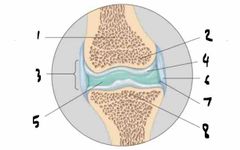
7. |
Synovial membrane |
|
|
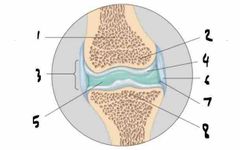
8. |
Articulating bone |
|
|
|
Osteomyelitis |
Uncommon bacterial infection of the bone. Occurs principally following bone trauma or in diabetics |
|
|
|
Tuberculosis |
Associated with untreated pulmonary tuberculosis. Occurs when bacteria spread from the lungs to the bones |
|
|
|
Pathogenesis of rheumatoid arthritis |
Rheumatoid factors(protein produces by immune system that can attack healthy tissue in body) form antibody complexes in the synovial fluid. This attracts neutrophils into the joint and cause inflammation |
|
|
|
Osteoporosis |
Porous bone that is abnormally fragile and susceptible to fracture |
|
|
|
Rickets |
A rare disease of infancy or early childhood in which the bones do not properly ossify, or harden |
|
|
|
Osteomalacia |
Softening or decalcification of bones in adults |
|
|
|
Scoliosis |
Abnormal lateral curvature of the spine |
|
|
|
Kyphosis |
Exaggerated posterior curve of the thoracic spine |
|
|
|
Lordosis |
Inward curvature of the lumbar vertebrae |
|
|
|
Osteogenic sarcoma |
A type of bone cancer, arises in the bony tissue itself and frequently affects the ends of long bones, especially the knee |
|
|
|
Arthritis |
Inflammation of a joint. Persistent joint pain and stiffness |
|
|
|
Rheumatoid arthritis |
Chronic autoimmune disease. Systemic inflammatory disease that affects several joints and thebsurround muscles. |
|
|
|
Rheumatoid factors |
Form antibody complexes in the synovial fluid. This then attracts neutrophils into the joints and cause rheumatoid arthritis |
|
|
|
Ankylosis |
Abnormal stiffening and immobility of a joint due to fusion of the bones |
|
|
|
Strain |
Result from a tearing of a muscle and/or its tendon |
|
|
|
Muscular dystrophy |
A group of muscle diseases that results in increasing weakening and breakdown of skeletal muscles |
|
|
|
Dystrophin |
A cytoskeletal protein |
|
|
|
Myasthenia gravis |
Disorder of the myoneural junction in which nerves fail to transmit an impulse for contraction to the muscle |
|
|
|
Rhabdyosarcoma |
Malignant rumor of skeletal muscle |
|
|
|
Osteoarthritis |
Most common form of arthritis |
|
|
|
Spurs |
A sharp irregular bony surface structure that develop along bone edges |
|
|
|
Gout |
A form of arthritis. Affects the joints of the feet. |
|
|
|
Septic arthritis |
Develops as a result of bacterial infection of a joint |
|
|
|
Bursitis |
Inflammation of bursae |
|
|
|
Bursae |
Small, synovial fluid-filled sacs located near the joints that cushion and reduce friction during movement |
|
|
|
Herniated discs |
Ruptured of the cartilaginous pads between the bony bodies of adjacent vertebrae |
|
|
|
Dislocation |
Dislocation |
Displacement of bones from their normal position in a joint |
|
|
Sprains |
Result from wrenching or twisting of a joint |
|

